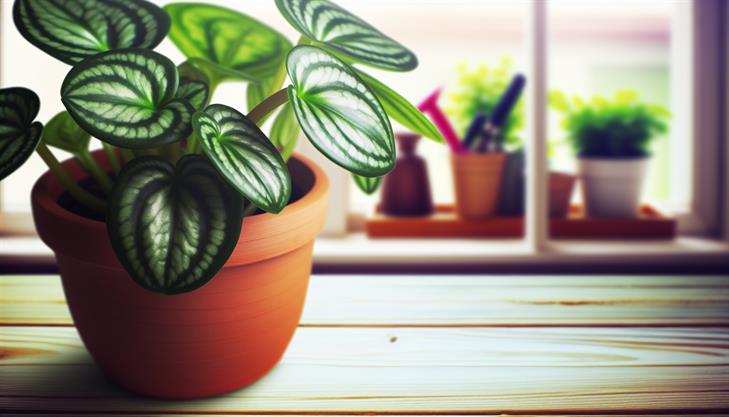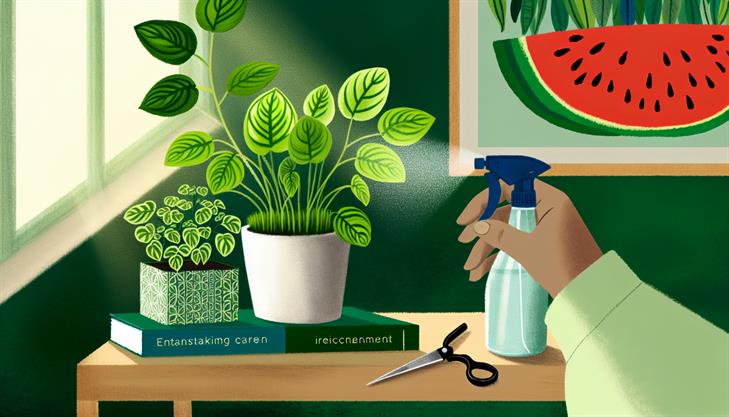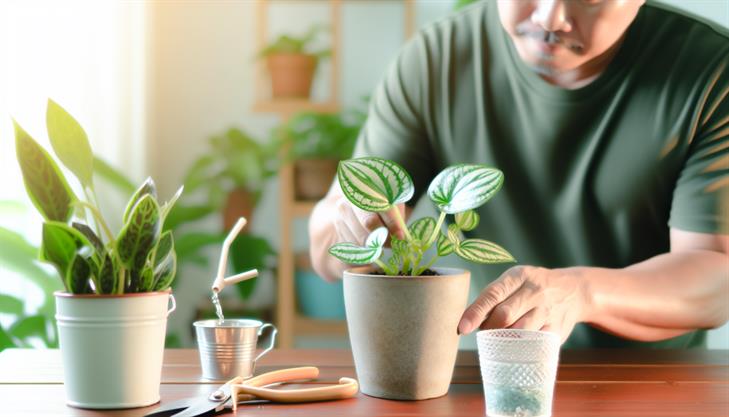Imagine having a petite plant that mirrors the beauty and charm of one of summer’s most beloved fruits. Watermelon Peperomia, with its distinctive green and silvery-striped leaves reminiscent of a watermelon rind, has become a darling among houseplant enthusiasts. But as you welcome this eye-catching greenery into your home, you might find yourself wondering: Do watermelon peperomias grow fast? Understanding the growth rate of this popular houseplant is essential not just for managing your expectations, but also for providing optimal care that encourages healthy development. Whether you’re a seasoned plant parent or a budding green thumb, delving into the growth habits of watermelon peperomia will equip you with the knowledge to nurture this beautiful plant, ensuring it remains a vibrant part of your indoor garden. Read on to discover expert insights and practical tips that will help you unlock the secrets to thriving watermelon peperomias.
Understanding Watermelon Peperomia Growth Rate
Watermelon Peperomia (Peperomia argyreia) is a stunning houseplant known for its unique, watermelon-like foliage. When considering adding this plant to your indoor garden, one common question is whether watermelon peperomia grows fast. Understanding the growth rate of watermelon peperomia can help you set realistic expectations and provide the best care for your plant.
Growth Rate Overview
Watermelon peperomia typically exhibits a moderate growth rate. Unlike some fast-growing plants, such as pothos or philodendrons, this peperomia species expands at a more controlled pace. On average, you can expect new leaves to develop every few weeks, with optimal growth occurring during the spring and summer months.
Factors Influencing Growth Rate
Several factors can influence the growth rate of watermelon peperomia:
-
Light Conditions: While watermelon peperomia can tolerate low light, it thrives in bright, indirect light. Insufficient light may slow down the growth process, so placing your plant near a north or east-facing window can encourage healthy expansion and more vigorous leaf production.
-
Watering Routine: Overwatering is a common issue that can stunt growth, as watermelon peperomia prefers slightly dry soil between waterings. Ensure the soil is allowed to dry to the touch before watering again, typically every 1-2 weeks, depending on the environment.
-
Temperature and Humidity: These plants do well in standard household temperatures of 65-75°F (18-24°C). As a tropical plant, they also appreciate higher humidity levels. If your area is dry, consider using a pebble tray or humidifier to enhance humidity, boosting growth rates.
Step-by-Step Care Tips
-
Optimal Potting Mix: Use a well-draining potting mix, such as one containing peat, perlite, or orchid bark, to prevent waterlogging which can hinder growth.
-
Regular Pruning: Occasionally prune leggy stems or dead leaves to encourage fuller growth. This helps the plant focus energy on developing vibrant, new foliage.
-
Fertilizing Schedule: During the growing season, feed your watermelon peperomia with a balanced, water-soluble fertilizer every four to six weeks. Avoid over-fertilization, as it can lead to leaf burn and slowed growth.
-
Repotting: While they don’t require frequent repotting, look to upgrade the pot size every 2-3 years or when the plant becomes root-bound, as a cramped root system can restrict growth.
Common Issues
-
Pest Infestation: Watch for signs of pests such as spider mites or aphids, which can impede growth. Use insecticidal soap or neem oil as treatment.
-
Leaf Droop: Droopy leaves can indicate overwatering or insufficient light. Adjust care routines accordingly for optimum growth conditions.
By providing the right environment, your watermelon peperomia can maintain its moderate growth rate and continue to flourish as a charming addition to your indoor plant collection. Taking these steps will not only ensure a healthy plant but also maximize its growth potential, allowing you to enjoy its beautiful leaves year-round.
Top Tips for Faster Growth of Watermelon Peperomia
Watermelon Peperomia (Peperomia argyreia) is a favorite among houseplant enthusiasts, known for its striking leaves that resemble watermelon rinds. While this plant is relatively easy to care for, many growers wonder whether watermelon peperomia grows fast and how they can encourage optimal growth. Let’s explore key tips to promote the healthy and faster growth of this appealing plant.
Understanding the Growth Pattern
-
Growth Rate: Watermelon Peperomia is considered a moderately slow grower under typical indoor conditions. However, with the right care and environment, it can flourish at a quicker pace.
-
Light Requirements: Providing adequate light is crucial for accelerating the growth of watermelon peperomia. These plants prefer bright, indirect sunlight. Direct sunlight can scorch their delicate leaves, whereas too little light can stunt their growth. Position your Peperomia near a north or east-facing window, or use sheer curtains to diffuse the light if placed in a sunnier spot.
-
Watering Setup: Overwatering is a common pitfall with Peperomia care, as these plants prefer their soil to dry out between watering sessions. Use your finger to check the top inch of the soil; if it’s dry, it’s time to water. Consistent watering helps avoid root rot and provides the right conditions for faster growth.
-
Soil and Potting: Watermelon Peperomia thrives in a well-aerated, fast-draining potting mix. A blend of peat, perlite, and potting soil often works best. Ensuring proper drainage also prevents water buildup, which can hamper plant health and growth.
-
Temperature and Humidity: These plants love warmth and humidity. Ideal temperature ranges from 65°F to 80°F (18°C – 27°C). While they adapt to average indoor humidity, maintaining slightly higher humidity levels can enhance their growth. Use a pebble tray or a humidifier if your home is particularly dry.
Enhancing Growth with Proper Care
-
Fertilization: Boost growth by feeding your Watermelon Peperomia with a balanced, water-soluble fertilizer every month during the growing season (spring and summer). Dilute the fertilizer to half the recommended strength to avoid fertilizer burn.
-
Propagation Tips: Growing new plants from cuttings is an enjoyable and effective way to expand your collection. Take healthy leaf cuttings and place them in water or soil to root. New plants will start to develop within a few weeks.
Addressing Common Issues
-
Leaf Drop: If you notice leaves falling, it could be due to inconsistent watering or low humidity. Adjust these conditions and monitor improvements.
-
Pest Management: Although typically low-maintenance, Watermelon Peperomia can occasionally attract pests like mealybugs or spider mites. Wipe leaves with a solution of water and mild soap, and keep plants clean and well-aired to prevent infestations.
By following these guidelines, you can encourage your Watermelon Peperomia to grow faster and maintain its vibrant appearance. Remember that while this plant requires some attention to its environment and care routine, the reward is a beautifully lush and decorative plant that enlivens any indoor space.
Essential Tools and Techniques for Healthy Growth
Watermelon peperomia, scientifically known as Peperomia argyreia, is a beloved houseplant renowned for its unique, watermelon-like leaf patterns. While it may not typically be categorized as a fast-growing plant, with the right conditions, you can optimize its growth and enjoy a thriving display. Understanding the growth rate and care essentials is key to cultivating a healthy watermelon peperomia.
Understanding the Growth Rate
Watermelon peperomia is generally considered a slow to moderate grower. Unlike some other houseplants that may shoot up quickly, it tends to expand more gradually. This doesn’t mean you can’t encourage healthy growth; it simply requires attentive care and the right environment.
Ideal Growing Conditions
-
Light Requirements:
These plants thrive in bright, indirect light. Direct sunlight can scorch the leaves, while too little light will stunt growth. If natural light is insufficient, consider using a grow light to provide consistent lighting conditions. -
Soil and Potting:
A well-draining potting mix is crucial for watermelon peperomia, as its roots are sensitive to waterlogging. You can use a mix designed for succulents or a blend of peat moss, perlite, and a bit of sand to ensure proper drainage. -
Watering Schedule:
Watermelon peperomia prefers to dry out slightly between waterings. Overwatering is a common problem that can lead to root rot, so ensure the top inch of soil feels dry before watering again. During winter, reduce watering as the plant’s growth slows down. -
Temperature and Humidity:
This plant flourishes in warm, humid environments, ideally between 65-80°F (18-27°C). If your home is particularly dry, especially in winter, consider using a humidity tray or a room humidifier. -
Fertilization:
Feeding your peperomia with a balanced liquid fertilizer every 4-6 weeks during the growing season (spring and summer) can promote healthier growth. Avoid fertilizing in the fall and winter as the plant’s growth naturally slows down.
Encouraging Growth
- Pruning: Regularly prune the plant to remove any dead leaves and encourage bushier growth. This also helps to maintain the plant’s aesthetic and health.
- Repotting: Repotting every couple of years or when the plant outgrows its container can stimulate growth. Choose a pot that is just slightly larger than the current one to avoid excessive soil that can retain too much moisture.
- Propagation: If you wish to expand your watermelon peperomia collection, propagation through leaf cuttings can be both fun and rewarding. Simply cut a healthy leaf with a stem, place it in water or soil, and with patience, it will root and start new growth.
Common Growth Issues
- Leaf Yellowing: Often a sign of overwatering or insufficient light. Adjust watering habits and ensure your plant receives adequate light.
- Leaf Drop: This may occur due to sudden temperature changes or drafts. Ensure consistent environmental conditions.
- Pest Infestation: Check for common pests such as spider mites or gnats. Use neem oil or insecticidal soap as a natural remedy.
By providing these optimal conditions and attentive care, your watermelon peperomia can thrive and gradually fill out its space, delighting you with its lush, decorative foliage. Patience and consistency are key — while it may not grow quickly, the beauty of this plant is well worth the effort.
Step-by-Step Care Guide for Watermelon Peperomia
Watermelon Peperomia, known for its unique foliage resembling watermelon rinds, is a popular choice for houseplant enthusiasts. If you’re wondering, "Do watermelon peperomia grow fast?" the answer is somewhat nuanced. Typically, Watermelon Peperomia is considered a moderate grower. Understanding their growth pattern and needs can help you optimize their development and enjoy a vibrant houseplant.
Growth Characteristics
Watermelon Peperomia generally grows more steadily than rapidly. They have a compact size, making them ideal for small spaces. While not fast growers like some other houseplants, they show noticeable growth under the right conditions. Here’s how you can ensure healthy development:
Light Requirements
Optimal Lighting: Place your Watermelon Peperomia in bright, indirect light. While they can tolerate lower light, insufficient lighting can slow their growth significantly. Avoid direct sunlight, as this can scorch their delicate leaves.
Light Adjustment Tip: Rotate the plant every few weeks to ensure that all sides receive even lighting. This promotes balanced growth.
Watering Routine
Consistency is Key: Water your Watermelon Peperomia when the top inch of the soil feels dry to the touch. Overwatering can lead to root rot, thus impeding growth.
Watering Tip: Use room-temperature water and ensure proper drainage. Occasional underwatering is preferable to frequent overwatering.
Temperature and Humidity
Preferred Climate: Watermelon Peperomias thrive in typical household temperatures between 65-75°F (18-24°C) and prefer moderate humidity levels.
Humidity Boost: If your home is particularly dry, use a room humidifier or place a tray of water nearby to increase humidity.
Soil and Potting
Ideal Soil: Use a well-draining potting mix, such as a blend designed for succulents or cacti, to prevent waterlogging.
Re-potting: If you notice roots protruding from the pot’s drainage holes, it’s time to re-pot. This typically happens every 2-3 years since they grow slowly.
Fertilizing Schedule
Balanced Nutrition: Feed your Watermelon Peperomia with a balanced, water-soluble fertilizer every 4-6 weeks during the growing season (spring and summer). Fertilization during fall and winter is unnecessary.
Fertilizing Tip: Always dilute the fertilizer to half strength to avoid over-fertilizing, which can damage the plant.
Common Issues
-
Slow Growth: Often related to insufficient light or overwatering. Adjust conditions accordingly and be patient; these plants don’t grow fast naturally.
-
Leaf Droop: Typically a sign of overwatering or inadequate light. Check soil moisture and light exposure.
-
Pest Problems: Although generally low-maintenance, watch out for pests like spider mites or mealybugs. Use insecticidal soap if needed.
In summary, while Watermelon Peperomia does not grow as quickly as some other houseplants, it can become a lush, full-bodied plant with proper care and conditions. Adopting these practices will ensure healthy growth and a visually appealing addition to your indoor plant collection.
Troubleshooting Common Growth Issues in Watermelon Peperomia
Watermelon Peperomia, scientifically known as Peperomia argyreia, is a popular houseplant admired for its bright, watermelon-like foliage. When it comes to growth, the question often arises: do Watermelon Peperomia grow fast? Generally, Watermelon Peperomia does not exhibit particularly rapid growth. It tends to grow at a moderate pace under optimal conditions and can vary based on several factors such as light, temperature, humidity, and care techniques.
Understanding Growth Pace
-
Growth Rate: Watermelon Peperomia grows more slowly compared to fast-growing indoor plants. You can expect modest growth, especially during its active growth seasons in spring and summer.
-
Size: Typically, these plants reach about 6 to 12 inches in height and spread 12 to 18 inches wide. This compact size is ideal for tabletops and windowsills, but don’t expect quick sprawling growth.
Setup Tips for Optimal Growth
-
Light: Ensure your Watermelon Peperomia receives bright, indirect sunlight. Direct sunlight can scorch the leaves while too little light can stunt growth. Place it near a north or east-facing window for optimal results.
-
Temperature and Humidity: These plants thrive in temperatures between 65°F to 75°F. Maintain higher humidity to mimic their natural habitat, which can be achieved by placing the pot on a humidity tray or using a humidifier.
-
Soil: Use a well-draining potting mix to prevent root rot. A blend of peat moss and perlite works excellent, allowing the roots to breathe while retaining necessary moisture.
Step-by-Step Care Instructions
-
Watering: Allow the top inch of soil to dry before watering. Water sparingly in winter months as the plant enters a dormant phase.
-
Feeding: Fertilize every month during the growing season with a balanced liquid fertilizer diluted to half strength. Over-fertilization can harm the roots and slow growth.
-
Pruning: Regularly prune dead or yellowed leaves to direct energy towards healthy growth.
-
Repotting: Repot every 2-3 years, or when the plant becomes root-bound, to encourage healthy growth.
Common Issues Affecting Growth
-
Leaf Drop: This can occur due to overwatering, underwatering, or root rot. Ensure proper watering practices and check the roots for any signs of rot.
-
Pests: Watch out for pests like spider mites and mealybugs, which can hinder growth. Treat infestations promptly with insecticidal soap or neem oil.
-
Leggy Growth: Insufficient light can lead to leggy stems. Move your plant to a brighter location to encourage a bushier appearance.
Additional Advice
For those wondering, “do Watermelon Peperomia grow fast compared to other plants?”, it’s helpful to remember that while they may not burst with rapid growth, their consistent and manageable size makes them perfect for indoor spaces. Regular care adjustments and attention to environmental conditions can ensure your Watermelon Peperomia remains healthy and aesthetically pleasing.
By following these guidelines and addressing common growth issues, you’ll help your Watermelon Peperomia thrive over time, even with its naturally leisurely growth rate.
In conclusion, watermelon peperomia, though adored for its lush foliage resembling the rind of a watermelon, tends to grow at a moderate pace. These charming houseplants thrive best in well-lit environments but away from direct sunlight, which can lead to leaf burn. Ensuring optimal growth conditions involves maintaining a consistent watering routine, providing adequate humidity, and applying fertilizer sparingly during their growing season. By understanding and catering to these specific care requirements, owners can nurture healthy plants that steadily expand over time.
For those eager to see a bit more growth from their watermelon peperomia, a final tip is to consider repotting these plants every few years. This can provide fresh soil and more space for root development, encouraging a healthier and potentially quicker growth rate. Remember, patience is key, and with the right care, your watermelon peperomia will flourish, gracing your space with its unique beauty.


